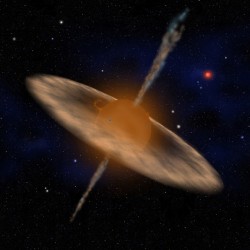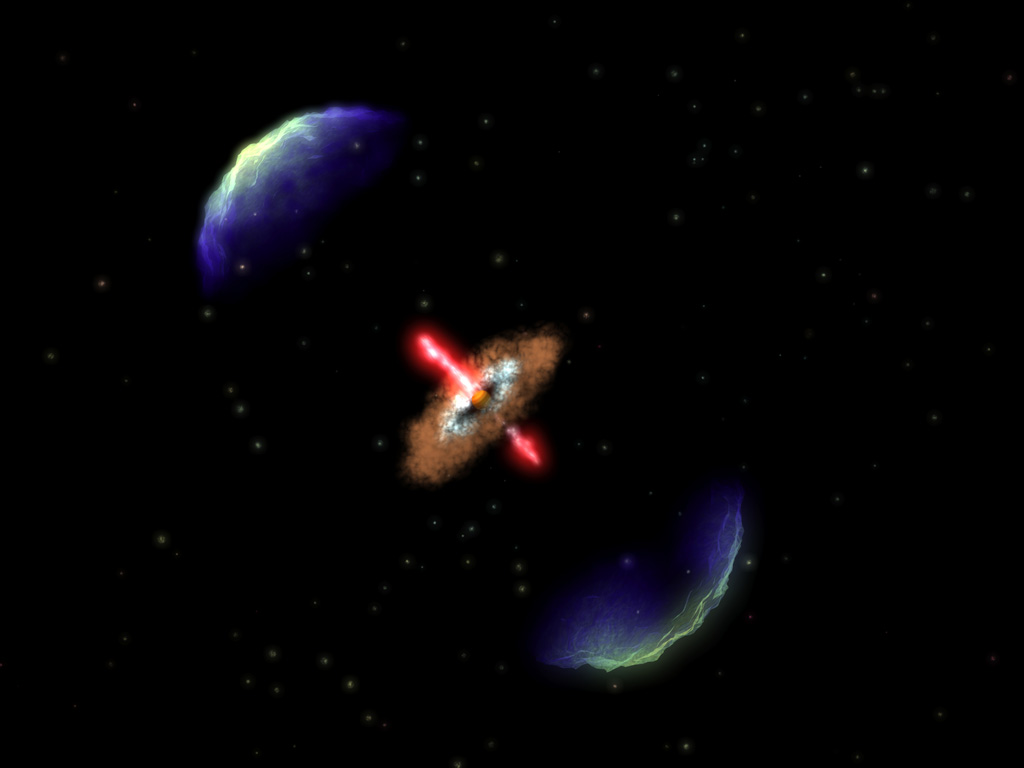[/caption]
Brown dwarfs are an interesting sort, and can only be classified in a kind of cosmic periphery between stars and planets: they are too small to be called stars and too large to be called planets. And astronomers haven’t been sure whether they form like stars, from the gravitational collapse of gas clouds, or if they form like planets, where rocky material comes together until it grows massive enough to draw in nearby gas. But now strong evidence has been found that brown dwarfs form more like stars. Using the Smithsonian’s Submillimeter Array (SMA), astronomers detected molecules of carbon monoxide shooting outward from a brown dwarf ISO-Oph 102. This type of molecular outflows typically is seen coming from young stars or protostars. However, this object has an estimated mass of 60 Jupiters, meaning it is too small to be a star, and has therefore been classified as a brown dwarf. But this new finding means brown dwarfs are more like stars than planets.
Typically, brown dwarfs have masses between 15 and 75 Jupiters, and the theoretical minimum mass for a star to sustain nuclear fusion is 75 times Jupiter. As a result, brown dwarfs are sometimes called failed stars. A star forms when a cloud of interstellar gas draws itself together through gravity, growing denser and hotter until fusion ignites. If the initial gas cloud is rotating, that rotation will speed up as it collapses inward, much like an ice skater drawing her arms in. In order to gather mass, the young protostar must somehow shed that angular momentum. It does so by spewing material in opposite directions as a bipolar outflow.

A brown dwarf is less massive than a star, so there is less gravity available to pull it together. As a result, astronomers debated whether a brown dwarf could form the same way as a star. Previous observations provided hints that they could. The serendipitous discovery of a bipolar molecular outflow at ISO-Oph 102 offers the first strong evidence in favor of brown dwarf formation through gravitational collapse.
As might be expected, the outflow contains much less mass than the outflow from a typical star: about 1000 times less, in fact. The outflow rate is also smaller by a factor of 100. In all respects, the molecular outflow of ISO-Oph 102 is a scaled-down version of the outflow process seen in young stars.
“These findings suggest that brown dwarfs and stars aren’t different because they formed in different ways,” said Paul Ho, an astronomer at the Harvard-Smithsonian Center for Astrophysics and director of ASIAA. “They share the same formation mechanism. Whether an object ends up as a brown dwarf or star apparently depends only on the amount of available material.”
The paper on ISO-Oph 102 will be published in the December 20 issue of the Astrophysical Journal Letters.
Source: CfA


I’m betting that low mass T or Y type brown dwarfs may also form in a way that’s similar to planet formation.
Either way, if you get enough mass to condense, you should get the same results, in a general sense.
I belive that the amount of mass available to condense down will determine that size of the star or brown dwarf. If there is only small amount of mass close by, you get a brown dwarf.
I think the same, that the formation of a brown dwarf depends on the amount of the material avalaible to the star.
If it is enough, collapses with much more weight and pressure, so triggers the ” real ” nuclear reactions.
The supergiants instead, like WR stars, for the opposite reasons, are triggering more than one nuclear reactions, creating Helium and heavier elements at the same time, not progressivly like the normal stars do.
I wonder if this may be evidence that all planets and stars are formed by the same basic mechanism. Thus, planetary systems may not really be very different from multiple stars (which are very common in the universe). Our solar system could thus be viewed as a special case of multiple star formation, in which only one body was large enough to be a star and all of the other bodies were Jupiter-sized or smaller. That would explain the gas giant planets. It might not explain the terrestrial planets.
In one of my astronomy books I red that the protoplanetary disc of the sun contained a lot of hydrogen and helium, a lot of oxygen, nitrogen and neon, minor quantities of silicon, iron and sulphur and small quantities of all the rest and heavier elements that were in the place after a nearby sypernova explosion.
As the protoplanetary disc was condensing, the particles of material formed bigger particles that in the next million years were getting bigger and bigger , forming the planetoids and finally, the planets.
The composition of these bodies was different. Near the center of the disc, the radiation of the sun pushed away the lighter gases, leaving rocks and metalls ( in licquid condition at the beginning ) in the area. Mercury, Venus, Earth, Moon and Mars were formed here. Farther, the area has been dominated by carbon, mixed with rocks and metalls ( asteroids ). More farther, there were materials rich in carbon, nitrogen and water ( outer asteroids and the small satellites of Jupiter ).
The sector of the disc that extents after Jupiter was cold enough, so it kept particles of ice, gas hydrogen and nitrogen ( Jupiter, Saturn and their major satellites ). The area after Saturn was very cold, so we find snow.
Poor brown dwarf — it is bi-polar. 😛
I Dont Get It 🙁